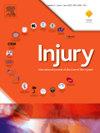Medial buttress plate use in neck of femur fracture fixations: A systematic review
IF 2.2
3区 医学
Q3 CRITICAL CARE MEDICINE
Injury-International Journal of the Care of the Injured
Pub Date : 2025-02-01
DOI:10.1016/j.injury.2025.112160
引用次数: 0
Abstract
Background
Femoral neck fractures, particularly Pauwels type II and III, pose significant challenges due to their vertical instability and susceptibility to complications such as non-union and avascular necrosis (AVN). Medial buttress plates (MBPs) have emerged as a promising adjunct in fixation, offering biomechanical advantages by neutralizing shearing forces and enhancing stability. However, the clinical efficacy of MBPs across different fixation techniques, plate configurations, and positioning remains unclear.
Purpose
This study aimed to (1) analyse outcomes of femoral neck fracture fixations augmented with MBPs, focusing on Pauwels type 2 and 3 fractures, and (2) analyse the impact of plate size, positioning, and the use of MBPs in different fixation techniques.
Study design
Systematic review; Level of evidence, 4.
Methods
Two independent reviewers performed a literature search based on PRISMA (Preferred Reporting Items for Systematic Reviews and Meta-analyses) guidelines using PubMed, MEDLINE, EMBASE, and Cochrane databases. Studies published from 2010 onwards, focusing on MBPs in Pauwels type II and III femoral neck fractures, were included. Clinical outcomes and plate details were recorded.
Results
Data from 21 studies, including 11 derived from meta-analyses, encompassing 642 patients were analysed. MBP-augmented fixations demonstrated a non-union rate of 6 %, an AVN rate of 4 %, and an overall failure rate of 17.3 %. The mean time to union was 3.9 ± 1.2 months, and the average HHS was 89.5 ± 5.5 at the final follow-up. Multiple cannulated screws (MCS) combined with a MBP showed a lower failure rate (14.6 %) compared to dynamic hip screw combined with a MBP (26.8 %), though not statistically significant (p = 0.164). Medial or anteromedial plate positioning yielded better outcomes, while anterior placement was associated with high failure rates. No studies examined the outcomes of femoral neck system fixation combined with a MBP.
Conclusion
MBPs are a valuable adjunct in managing Pauwels type II and III femoral neck fractures, providing favourable outcomes with low rates of failure and complications. The combination of MBPs with various fixation techniques has shown promising results, highlighting the potential for improved stability and outcomes. Further research is needed to optimize plate size, screw type, positioning, and the role of MBPs in augmenting fixation techniques for these challenging fractures.
内侧支撑钢板在股骨颈骨折固定中的应用:系统回顾。
背景:股骨颈骨折,特别是保韦氏II型和III型,由于其垂直不稳定和易发生并发症,如骨不愈合和无血管坏死(AVN),构成了重大挑战。内侧支撑板(MBPs)已成为一种很有前途的固定辅助装置,通过中和剪切力和增强稳定性提供生物力学优势。然而,MBPs在不同固定技术、钢板配置和定位上的临床疗效尚不清楚。目的:本研究旨在(1)分析MBPs增强股骨颈骨折固定的结果,重点是Pauwels 2型和3型骨折;(2)分析不同固定技术中钢板大小、定位和MBPs使用的影响。研究设计:系统评价;证据等级,4级。方法:两位独立的审稿人使用PubMed、MEDLINE、EMBASE和Cochrane数据库,根据PRISMA(系统评价和meta分析的首选报告项目)指南进行文献检索。从2010年开始发表的研究集中在Pauwels II型和III型股骨颈骨折的MBPs。记录临床结果和钢板细节。结果:21项研究的数据,其中11项来自荟萃分析,共分析了642例患者。mbp增强固定显示不愈合率为6%,AVN率为4%,总体失败率为17.3%。平均愈合时间为3.9±1.2个月,终末随访时平均HHS为89.5±5.5。与动态髋螺钉联合MBP(26.8%)相比,多空心螺钉联合MBP的失败率(14.6%)较低,但无统计学意义(p = 0.164)。内侧或前内侧钢板定位效果较好,而前部置入失败率较高。没有研究检查股骨颈系统固定联合MBP的结果。结论:MBPs是治疗Pauwels II型和III型股骨颈骨折的一种有价值的辅助手段,具有较低的失败率和并发症。MBPs与各种固定技术的结合显示出有希望的结果,突出了改善稳定性和结果的潜力。需要进一步的研究来优化钢板尺寸、螺钉类型、定位以及MBPs在这些具有挑战性的骨折中增加固定技术的作用。
本文章由计算机程序翻译,如有差异,请以英文原文为准。
求助全文
约1分钟内获得全文
求助全文
来源期刊
CiteScore
4.00
自引率
8.00%
发文量
699
审稿时长
96 days
期刊介绍:
Injury was founded in 1969 and is an international journal dealing with all aspects of trauma care and accident surgery. Our primary aim is to facilitate the exchange of ideas, techniques and information among all members of the trauma team.

 求助内容:
求助内容: 应助结果提醒方式:
应助结果提醒方式:


